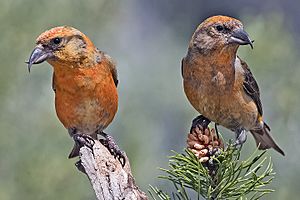Crossbill facts for kids
Quick facts for kids Crossbill |
|
|---|---|
 |
|
| male red crossbills (Loxia curvirostra) | |
| Scientific classification | |
| Kingdom: | |
| Phylum: | |
| Class: | |
| Order: | |
| Family: | |
| Genus: |
Loxia
Linnaeus, 1758
|
The crossbills are a type of bird from the finch family, known for their unique beaks. These special birds have mandibles (the parts of their beak) that cross over each other at the tips. This unusual shape gives them their name!
Adult male crossbills are usually red or orange. Female crossbills are typically green or yellow. However, their colors can vary quite a bit.
Contents
What Makes Crossbills Special?
Crossbills are expert eaters of conifer cones. Their unique bill shape is a special adaptation that helps them get seeds from these cones. No other animal can get to these seeds as easily or as early as a crossbill can.
How Their Beaks Work
A crossbill uses its beak like a tool. It puts the slightly open beak between the scales of a conifer cone. Then, it closes its beak. This action pushes the cone scales apart. This clever trick lets the bird reach the seeds hidden inside. Each cone scale usually holds two seeds.
Cones naturally open up when they are dry and close when they are wet. Eventually, cones fall to the ground. As they dry, their scales open, and any animal can get the seeds. But with their special beaks, crossbills can get the seeds much earlier than other animals. This gives them a big advantage!
Where Do Crossbills Live?
These birds are usually found in the northern parts of the world. This includes places with higher northern hemisphere latitudes. These are the areas where their main food source, conifer trees, grow.
Sometimes, if there aren't enough cones in their usual breeding areas, crossbills will fly to new places. This movement is called an "eruption." They do this to find more food.
When Do They Have Babies?
Crossbills breed very early in the year. They often start having their young during the winter months. This timing helps them make the most of the cone supply. There are usually plenty of cones available during this time.
Images for kids
-
Red crossbill skull and jaw anatomy from William Yarrell's A History of British Birds (1843)
See also
 In Spanish: Piquituertos para niños
In Spanish: Piquituertos para niños


